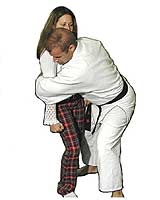Releasing The Arms To Counter A Front Bear Hug
By Prof. Gene Roos
 There are many self-defense techniques against a front bear hug. And
many include a strike to the attacker’s groin. If this strike is
effective the attacker will often opens his arms or release his grip.
This allows the defender to follow up with a kick, punch, or throw of
the assailant. There are many self-defense techniques against a front bear hug. And
many include a strike to the attacker’s groin. If this strike is
effective the attacker will often opens his arms or release his grip.
This allows the defender to follow up with a kick, punch, or throw of
the assailant.
The problem is that too often the defender isn’t taught how to
free an arm so this strike can be effective.
Too often practice is not realistic -- the attacking partner often just
loosely wraps his arms around the front of the defender. The defender
is then taught to deliver a front strike with one hand or fist into the
attacker’s groin. This only works, however, when the attacker’s
grab isn’t tight.
In combat or in real-life assault situations things are usually very
different. The attacker’s grab is usually tight and powerful. This
grip locks the defender’s elbows against his or her sides. If the
arms can be moved at all, any groin or other strike is so restricted
that the counter becomes ineffective. Thus, what the student has learned
suddenly becomes ineffective at the very moment when it is most needed.
|
|
Attacker grabs defender’s
chest from the front |
Incorrect – Defender attempts a right-hand strike to the
attacker’s groin. The defender’s right elbow is locked
and her hand cannot strike the attacker’s groin. |
|
|
Correct – Defender squats and moves her
hips to the left rear. |
Then the defender shifts her hips and right
hand forward. Her hand strikes the attacker’s groin. In
this position the defender can forcibly strike (elbow is not
locked) the attacker. |
There is a simple solution. When faced with a tight front bear hug,
the defender can partially release the tight grip and create space for
movement by squatting downward (letting the defender’s weight pull
on the arms to loosen them). The defender can then shift his or her hips
to the side (here, the left). This releases the attacker’s grip
on the elbows and creates room for movement. Since the defender’s
elbows are no longer locked to his sides, significant power can be generated
to attack the attacker’s groin.
About the Author:
Prof. Gene Roos, 9th dan Ju Jitsu, and 4th dan in judo, is a member
of the Board of Directors for the America Ju Jitsu Association. In 1958
was awarded Shodan (Judo) and won the Regional Judo Champion. In 1958 & 1959
was Judo State Champion. His instructors include: Harold Brosious (Ketsugo),
Dennis Palumbo (Hakko Ryu Ju Jitsu, 8th Dan), George Kirby, & Shizuya
Sato (Ju Jitsu), Wally Jay (Small Circle Ju Jitsu), Dr. Sacharnoski (Hard
Style Ju Jitsu & Ki) and Master Mochizuki (a student of Funakoshi,
Kano, & Ueshiba). He is also the author of a series of upcoming books
on Aiki jujitsu as well as a number of videos including: "Aiki Jujitsu" (a
three video tapes series with manuals); "Deadly Attacks" (defense
against 30 knife, gun, stick and empty hand attacks); "Deadly Attacks-
part II" (defense against an additional 30 knife, gun and empty
hand attacks); "Deadly Attacks III" and "Devastating Throws
and Other Deadly Attacks " (defense against 30 advanced combat throws,
knife attacks, stick, and a rear shotgun attack), For more information
see: http://www.aikijujitsu.homestead.com/aikijujitsu.html
|